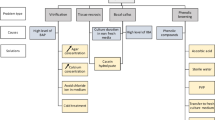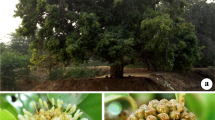Abstract
Key message
A protocol is presented for the micropropagation and short-term conservation of Quercus lusitanica Lam.
Abstract
This is the first time that a simple protocol is presented for the micropropagation and short-term conservation of Quercus lusitanica, an endemic and endangered species that is found in very restricted habitats of the Iberian Peninsula and North Africa. Branch segments from 15- to 20-year-old trees were forced-flushed, and the forced shoots were used as a source of explants for culture initiation. The best multiplication rates were obtained on Woody Plant Medium (WPM) supplemented with 0.1 mg l−1 benzyladenine for the genotype CDL, or 0.2 mg l−1 benzyladenine, 0.5 mg l−1 indole acetic acid, and 0.2 mg l−1 zeatin in the case of the genotype SC1. Although the cultivation of shoots in the horizontal position improved the proliferation rates, the shoot vitrification was increased under these conditions. The best rooting rates were obtained on half-strength WPM supplemented with 3 mg l−1 indole-3-butyric acid for 7 days with subsequent transfer to auxin-free medium supplemented with 0.4% activated charcoal. An initial 5-day dark period was detrimental to the quality of regenerated plantlets. Well-acclimatized plantlets were transferred to the field with a 70% survival rate.


Similar content being viewed by others
References
Anten NPR, Casado-García R, Pierik R, Pons TL (2006) Ethylene sensitivity affects changes in growth patterns, but not stem properties, in response to mechanical stress in tobacco. Physiol Plant 128:274–282
Bunn E (2005) Development of in vitro methods for ex situ conservation of Eucalyptus impensa, an endangered malle from southwest Western Australia. Plant Cell Tissue Organ Cult 83:97–102
Cabezudo B, Talavera S, Blanca G, Salazar C, Cueto M, Valdés B, Hernández-Bermejo JE, Herrera CM, Rodríguez Hiraldo C, Navas D (2005) Lista roja de la flora vascular de Andalucía. Consejería de medio ambiente, Junta de Andalucía
Fay MF (1992) Conservation of rare and endangered plants using in vitro methods. In Vitro Cell Dev Biol Plant 28:1–4
Fernández Rodríguez R, Faria C, Matzen J, Simões F, Almeida MH, Rigueiro Rodríguez A (2005) Identificación mediante técnicas moleculares de Quercus lusitanica Lam. y estudio de técnicas de propagación como base para la conservación de esta especie. 5° Congreso Forestal Nacional. Viseu, Portugal
Gatti E, Sgarbi E (2015) Micropropagation of Quercus robur explant sources and cultural conditions affect in vitro responses differently. Acta Hortic 1083:303–310
Gonçalves S, Fernandes L, Romano A (2010) High-frequency in vitro propagation of the endangered species Tuberaria major. Plant Cell Tissue Organ Cult 101:359–363
Gresshoff PM, Doy CH (1972) Development and differentiation of haploid Lycopersicon esculentum. Planta 107:161–170
Guo B, Gao M, Liu CZ (2007) In vitro propagation of an endangered medicinal plant Saussurea involucrata Kar. et Kir. Plant Cell Rep 26:261–265
Hill P, Gutierrez L, Carmack L, Kopp OR (2015) Micropropagation of Astragalus holgreniorum (Holmgren milkvetch), and endemic and endangered species. Plant Cell Tissue Organ Cult 121:381–387
Hoagland DR, Arnon DI (1941) The water culture method for growing plants without soil. Miscellaneous Publications 3515. Circular of the California Agricultural Experimental Station, pp 347–361
Jayaram K, Prasad MNV (2007) Rapid in vitro multiplication of Drosera indica L.: a vulnerable, insectivorous plant. Plant Biotechnol Rep 1:79–84
Lebtahi F, Errahmani MB, Bouguedoura N (2015) Propagation of cork oak (Quercus suber L.) by axillary shoot and somatic embryogenesis. Propag Ornam Plants 15:113–122
Liao YK, Chuang MC (2014) Micropropagation of Quercus aliena var. aliena from explants of mature trees. Taiwan J Forest Sci 29:117–131
Lloyd G, McCown B (1980) Commercially-feasible micropropagation of mountain laurel, Kalmia latifolia, by use of shoot-tip culture. Comb Proc Int Plant Prop Soc 30:421–427
Mackay WA, Kitto SL (1988) Factors affecting in vitro shoot proliferation of French Tarragon. J Amer Soc Hortic Sci 2:282–287
Mallón R, Rodríguez-Oubiña J, González ML (2010) In vitro propagation of the endangered plant Centaurea ultreiae: assessment of genetic stability by cytological studies, flow cytometry and RAPD analysis. Plant Cell Tissue Organ Cult 101:31–39
Muliawan SY, Kit LS, Devi S, Hashim O, Yusof R (2006) Inhibitory potential of Quercus lusitanica extract on Dengue virus type 2 replication. Southeast Asian J Trop Med Public Health 37:132–135
Murashige T, Skoog F (1962) A revised medium for rapid growth and bioassays with tobacco tissue culture. Physiol Plant 15:473–497
Ostrolucká MG, Gajdosová A, Libiaková G (2007) Protocol for micropropagation of Quercus spp. In: Jain SM, Häggman (eds) Protocols for micropropagation of woody trees and fruits. Springer, The Netherlands, pp 85–91
Pandey A, Tamta S (2014) In vitro propagation of the important tasar oak (Quercus serrata Thunb.) by casein hydrolysate promoted high frequency shoot proliferation. J Sustain Forest 33:590–603
Pence VC (2013) In vitro methods and the challenge of exceptional species for target 8 of the global strategy for plant conservation. Ann Miss Bot Gard 99:214–220
Piovan A, Caniato R, Mariella Cappelletti E, Filippini R (2010) Organogenesis from shoot segments and via callus of endangered Kosteletzkya pentacarpos (L.) Ledeb. Plant Cell Tissue Organ Cult 100:309–315
Puddephat IJ, Alderson PG, Wright NA (1999) In vitro root induction in axillary microshoots of Quercus robur L. Ann Appl Biol 134:233–239
Romano A, Martins-Louçao MA (2003) Strategies to improve rooting and acclimatization of cork oak. Acta Hortic 616:275–278
Romano A, Noronha C, Martins-Louçao MA (1992) Influence of growth regulators on shoot proliferation in Quercus suber L. Ann Bot 70:531–536
San José MC, Ballester A, Vieitez AM (1988) Factors affecting in vitro propagation of Quercus robur L. Tree Physiol 4:281–290
San José MC, Vieitez AM, Ballester A (1990) Clonal propagation of juvenile and adult trees of sessile oak by tissue culture. Silvae Genet 39:50–55
San José MC, Janeiro LV, Corredoira E (2013) Micropropagation of threatened black alder. Silva Fenn 47:1–12
Sánchez MC, San José MC, Ballester A, Vieitez AM (1996) Requirements for in vitro rooting of Quercus robur and Q. rubra shoots derived from mature trees. Tree Physiol 16:673–680
Sarasan V, Cripps R, Ramsay MM, Atherton C, McMichen M, Prendergast G, Rowntree JK (2006) Conservation in vitro of threatened plants—progress in the past decade. In Vitro Cell Dev Biol Plant 42:206–214
Tamta S, Palni LM, Purohit VK, Nandi SK (2008) In vitro propagation of brown oak (Quercus semecarpifolia Sm.) from seedling explants. In Vitro Cell Dev Biol Plant 44:136–141
Thomas TD (2008) The role of activated charcoal in plant tissue culture. Biotechnol Adv 26:618–631
Vázquez FM, Gutiérrez M, Blanco J, García D, Guerra MJ, Márquez F, Cabeza de Vaca MA, López JL, Sánchez A, Palacios MJ, Mateos JA (2010) Catálogo regional de especies vegetales amenazadas de Extremadura. Junta de Extremadura, Colección Medio Ambiente, Consejería de Industria, Energía y Medio Ambiente, Junta de Extremadura, Mérida, España, 441 p
Vengadesan G, Pijut PM (2009) Somatic embryogenesis and plant regeneration of northern red oak (Quercus rubra L.). Plant Cell, Tissue Organ Cult 97:141–149
Vieitez AM, San José MC, Vieitez E (1985) In vitro plantlet regeneration from juvenile and mature Quercus robur L. J Hortic Sci 60:99–106
Vieitez AM, Ferro EM, Ballester A (1993a) Micropropagation of Fagus sylvatica L. In Vitro Cell Dev Biol Plant 29:183–188
Vieitez AM, Pintos F, San José MC, Ballester A (1993b) In vitro shoot proliferation determined by explant orientation of juvenile and mature Quercus rubra L. Tree Phsyiol 12:107–117
Vieitez AM, Sánchez MC, Amomarco JB, Ballester A (1994) Forced flushing of branch segments as a method for obtaining reactive explants of mature Quercus robur trees for micropropagation. Plant Cell Tissue Organ Cult 37:287–295
Vieitez AM, San José MC, Sánchez C, Ballester A (2003) Micropropagation of Fagus spp. In: Jain SM, Ishii K (eds) Micropropagation of woody trees and fruits. Kluwer, Dordrecht, pp 181–215
Vieitez AM, Corredoira E, Ballester A, Muñoz F, Durán J, Ibarra M (2009) In vitro regeneration of important North American oak species Quercus alba, Quercus bicolor, Quercus rubra. Plant Cell Tissue Organ Cult 98:135–145
Vieitez AM, Corredoira E, Martínez MT, San José MC, Sánchez C, Valladares S, Vidal N, Ballester A (2012) Application of biotechnological tools to Quercus improvement. Eur J Forest Res 131:519–539
Werner T, Motyka V, Strnad M, Schmülling T (2001) Regulation of plant growth by citokynin. Proc Nat Acad Sci 98:10487–10492
Wildi E, Schaffner W, Berger Büter K (1998) In vitro propagation of Petasites hybridus (Asteraceae) from leaf and petiole explants and from inflorescence buds. Plant Cell Rep 18:336–340
Yeang HY, Hillman JR (1984) Ethylene and apical dominance. Physiol Plant 60:275–282
Acknowledgements
We thank the Asociación Monte Pindo Parque Natural (AMPPN) and Dr. EV Carral for kindly providing the plant material used in this study, and Dr. S González Prieto for providing the photos of the trees. Thanks are also given to Mr. JC Suárez San Martín and N Blázquez for their technical support.
Author information
Authors and Affiliations
Corresponding author
Ethics declarations
Conflict of interest
The authors declare that they have no conflict of interest.
Additional information
Communicated by S. Merkle.
Rights and permissions
About this article
Cite this article
José, M.C.S., Martínez, M.T., Cernadas, M.J. et al. Biotechnological efforts for the propagation of Quercus lusitanica Lam., an endangered species. Trees 31, 1571–1581 (2017). https://doi.org/10.1007/s00468-017-1570-2
Received:
Accepted:
Published:
Issue Date:
DOI: https://doi.org/10.1007/s00468-017-1570-2




